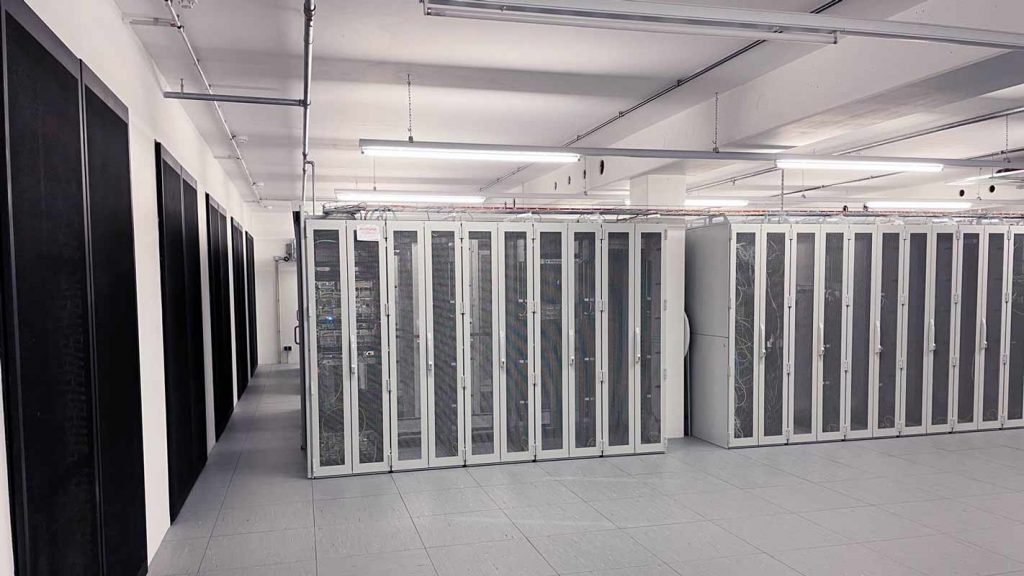As part of a larger customer project, we implemented SONiC Open Networking for the first time in our data centers for a private cloud application. We are excited about the functionalities like an automated configuration with Ansible and would like to introduce SONiC as an open source solution for disaggregated networking.
Why is SONiC Open Networking such a big hype topic?
In the past, the network was an IT resource to which few business leaders paid attention. With digital transformation, this view has changed rapidly. This is due to new network-centric technologies such as cloud computing, edge computing, IoT and artificial intelligence, and live streaming. They have significantly increased the strategic value of the network to enterprises. It can be said that it has become a competitive differentiator. The increasing demand for higher speeds, more bandwidth and lower latency has put the network at the center of the IT world. Data and applications are no longer confined to central data centers, but must be transported quickly back and forth between these data centers, the periphery and multiple clouds.
As a result, networks have changed dramatically. They have been virtualized through software-defined networking (SDN), network-function virtualization (NFV) and software-defined WAN (SD-WAN). They have also become much smarter and more agile. Decoupling the data plane and network functions from the underlying proprietary hardware has led to open switches that can run third-party operating systems and software (open networking hardware).
In today's connected world, the network has become the backbone of modern businesses. Whether it is data exchange, communication between devices or access to cloud-based services, a reliable and flexible network infrastructure is essential. One innovative solution that has become increasingly important in recent years is SONiC Open Networking. This article presents the advantages and possible uses of SONiC, as well as some of the leading providers in this field.
What is SONiC?
SONiC stands for Software for Open Networking in the Cloud and is an open source operating system for network devices. At its core, SONiC enables the separation of software and hardware, resulting in a flexible, scalable and cost-effective network architecture. With SONiC, enterprises can develop their own network devices or use existing devices based on this operating system. Specifically, SONiC is a collection of kernel patches, platform device drivers, a Platform Abstraction Library (PAL), a switch cache database (also known as Switch State Service) and utilities, e.g. for editing the switch cache database or accessing front panel ports. Combined with a Linux distribution like Debian Jessie, you get a real NOS.
SONiC was originally developed by Microsoft for the Azure Cloud and is now managed by the Linux Foundation. The underlying architecture of SONiC is described on GitHub (sonic-net.github.io). In addition, there is the SONiC Test Sub-Project under the direction of the OCP Networking Project Group. SONiC thus has a large developer community and a broad vendor ecosystem. Network switches from various manufacturers (except Cisco and Juniper) are almost always frequently based on chips from Broadcom. The differences in hardware are therefore relatively small. In the SONiC test sub-project, the co-design of hardware and software is therefore focused on the software, which in turn requires a detailed knowledge of the hardware to maximize hardware performance and accelerate hardware time-to-market. This is because system performance and the environmental footprint of devices depend heavily on the interaction between software and hardware.
SONiC is based on the Switch Abstraction Interface (SAI), which defines a standardized API for network operating system communication. , to control vendor-independent forwarding elements such as a switching ASIC, an NPU or a software switch in a uniform manner. Network hardware vendors can use this to develop innovative hardware platforms that achieve high speeds while providing a consistent programming interface to ASICs (Application Specific Integrated Circuits). This approach enables operators to take advantage of rapid innovations in silicon, CPU, power, port density, optics and speed, while protecting their investment in a unified software solution across multiple platforms.
In the meantime, there are also commercial distributors like Broadcom, which offer extensions e.g. for virtualization (Aviz ONE) and comprehensive support.
Advantages of SONiC:
Why is it worth considering the use of SONiC? Although the suitability of disaggregated networking technology certainly depends heavily on the particular use case, Open Networking offers advantages that can be very helpful for some use cases:
Flexibility and adaptability: SONiC provides a highly customizable platform on which enterprises can configure their network architecture according to their specific requirements. It enables the integration of third-party applications and services, increasing choice and flexibility.
Scalability: With SONiC, companies can seamlessly scale and automate their network, i.e. control all hardware elements in the network via a uniform structure (SDN). By separating software from hardware and further virtualization, users can add or replace devices regardless of manufacturer without having to rebuild the entire infrastructure. New features and updates can be rolled out without affecting users.
Cost savings: By using SONiC, companies can avoid expensive proprietary network devices. Instead, they can rely on low-cost hardware and take advantage of the open source operating system, resulting in significant cost savings. Further automation eliminates duplication of effort as well as errors and leads to fully automated troubleshooting in the event of failures.
Use cases - Where can SONiC be used?
Data centers: SONiC is particularly well suited for data center deployments because it provides an agile network architecture that meets the demands of cloud computing and Big Data. It enables the operation of high-speed networks and the seamless scaling of resources.
Telecommunications: In the telecommunications sector, SONiC can help improve network efficiency and reduce costs. By using open standards and integrating virtualization technologies, it enables faster service provisioning and more flexible network configuration. SONiC is used by Deutsche Telekom, among others.
Service Provider: SONiC offers service providers the opportunity to optimize their network infrastructure while reducing operating costs. By supporting multi-tenancy and integrating virtualization technologies, service providers can offer their customers tailored services with higher quality and reliability.
But larger companies and retailers can also benefit from SONiC.
Provider of SONiC:
Although SONiC is an open source project, there are a growing number of companies that support SONiC and offer commercial solutions based on this operating system. Some of the leading vendors, but not to be evaluated further here, are:
Arista Networks (Hardware): Arista is a leading provider of cloud networking and data center solutions. They offer switches and routers that can be operated with SONiC to meet the requirements of modern network infrastructures.
Broadcom (Software /Distribution): Broadcom, along with Microsoft, is among the most involved in the continued development of SONiC and has its own SONiC distribution. As a leading provider of data center solutions, Broadcom offers a comprehensive portfolio of network, server and storage connectivity.
Dell Technologies (Hardware & Software): Dell offers a range of networking devices that are compatible with SONiC. These devices provide high performance, scalability and flexibility for data centers and enterprise networks.
Edgecore Networks (Hardware & Software): Edgecore Networks provides network switches primarily for bare metal application areas in data centers, enterprise, retail and high performance computing. Integration with third-party offerings supports automation and validation of the entire data center network.
NVIDIA (Hardware): NVIDIA offers networking devices and solutions for data centers and cloud computing environments based on SONiC. These solutions provide high bandwidth, low latency, and optimized performance for demanding applications. NVIDA is also a provider of the SONiC alternative Cumulus Linux, which is very similar in functionality, with Cumulus Linux offering a wider choice in Mellanox ASICS, particularly supporting AI and storage networking.
STORDIS GmbH (Hardware and Software): STORDIS is a leading provider in the EMEA region, offering comprehensive open networking solutions, including consulting, solution design, integration and support services, certified training, and custom network tool development. STORDIS develops various switch operating systems (NOS), NetOps/DevOps automation platforms, and monitoring and management frameworks.
The nature and extent of support for SONiC from the vendors mentioned varies widely. Some offer special hardware platforms optimized for SONiC, while others provide services and support for the implementation and management of SONiC-based networks.
Conclusion
SONiC Open Networking is an innovative solution that is revolutionizing the way enterprises build and manage their network infrastructure. Through its flexibility, scalability and cost efficiency, SONiC enables optimized use of network resources. SONiC's wide range of applications in areas such as data centers, telecommunications and service providers make it a technology of the future. With many leading vendors and enhancements, there is a wide range of options for enterprises looking to deploy SONiC.



